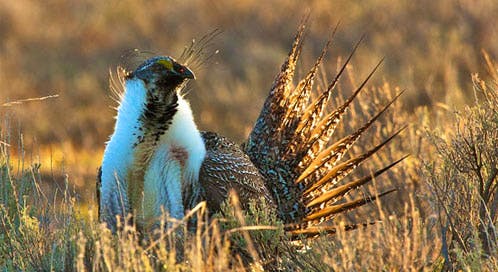Birders are a particularly active segment of wildlife-watchers, “flocking” to locales near and far to watch spring and fall migrations. Local and regional festivals celebrate different species throughout the year – hummingbirds in August, raptors in October, and sandhill cranes in November. And now, a new wave of watching has taken hold out west: Bunkering down in a bird blind to catch an early-morning show of sage-grouse performing their ancient and elaborate mating display during March and April.
We hit the road this spring to join a group of wildlife watchers enamored by sage-grouse. Two vans full of Defenders supporters and staff joined colleagues at Conservation Colorado for the fourth annual Sagebrush Safari: Greater Sage-Grouse Lek Tour in Craig, Colorado.
We were up well before dawn on a chilly Monday morning, and after driving for about an hour, we hiked to a viewing blind eagerly anticipating the show. We could hear the birds before we could see them and then, as the sun rose, even the most experienced birders among us were stunned by what we saw. The scene was extraordinary—at one point we counted 126 birds, including more than a hundred overly-confident males displaying for potential mates.
[slideshow_deploy id=’26636′]
(Photos © John Yeingst/Defenders)
The sage-grouse mating ritual is fascinating to observe, and often described as among the most stirring and colorful natural history pageants in the West. At dawn and often at dusk in early spring, sage-grouse congregate on “leks”—ancestral strutting grounds to which the birds return year after year. Leks vary in size from one to 40 acres and may be up to 50 miles from the birds’ other seasonal habitats. To attract a hen, cocks strut, fan their tail feathers and swell their breasts to reveal vibrant yellow air sacs. The combination of wing movements and inflating and deflating air sacs make an utterly unique sight and sound, “swish-swish-coo-oopoink!”
The trip left us all with even greater enthusiasm for conserving this charismatic species, especially after seeing firsthand the importance of leks, which are critical to sage-grouse reproduction. Most hens will nest within four miles of the lek where they mated, and habitat degradation around leks from humanactivities can reduce nesting success and brood production. State and federal strategies to conserve sage-grouse must protect sage-grouse leks, nesting and brood-rearing habitat to support the species’ persistence.
Wildlife-watching is an exciting and educational way to engage with nature. It’s also a booming economic sector that is profiting tourism and recreation industries across the country, especially in local communities where wildlife lives. We were warmly welcomed by the Craig business community on our trip to Colorado.
A number of other western grouse, many of which are threatened or endangered, also use lek-mating systems, including Gunnison sage-grouse, greater prairie-chicken, lesser prairie-chicken and all varieties of sharp-tailed grouse. Opportunities abound to see all of these grouse in action. We encourage you to grab your camera—and some warm clothes—and head west to see the grouse. You won’t be disappointed.
John Yeingst, Communications Coordinator
Mark Salvo, Director of Federal Lands Conservation
From the Blog






Follow Defenders of Wildlife
facebook twitter instagram youtube tiktok threads